I seem to be on a social studies bing
More on teaching history
Climate change resources
With all that is going on, I think that learning about the dangers of climate change has been slighted. 60 Minutes has had two recent segments relevant to climate change that educators wanting to discuss climate change might use in their classrooms.
The first segment is an interview with David Attenborough who has spent a lifetime bringing the study of the Earth through BBC documentaries. The interview itself contains some spectacular video segments.
The following week 60 Minutes had another interview focused on recent evidence of climate change (severe weather, California fires) with scientist Reed Rankin considered by many to be the “father of climate science”. Again, the program segment contains some great video in support of the narrative.
Internet archive scholar
Richard Byrne had a recent post describing the Internet Archive Scholar – a new project from the Internet Archive focused on scholarly publications. This is new resource is still under developed, described as as alpha, but it intends to cover the academic journals from 1800 through the present.
So, I made an effort to investigate and like any good scholar exploring such a resource I decided to search for myself. Those who who regularly search for scholarly articles probably understand that the alternate publicly available service would be Google Scholar.
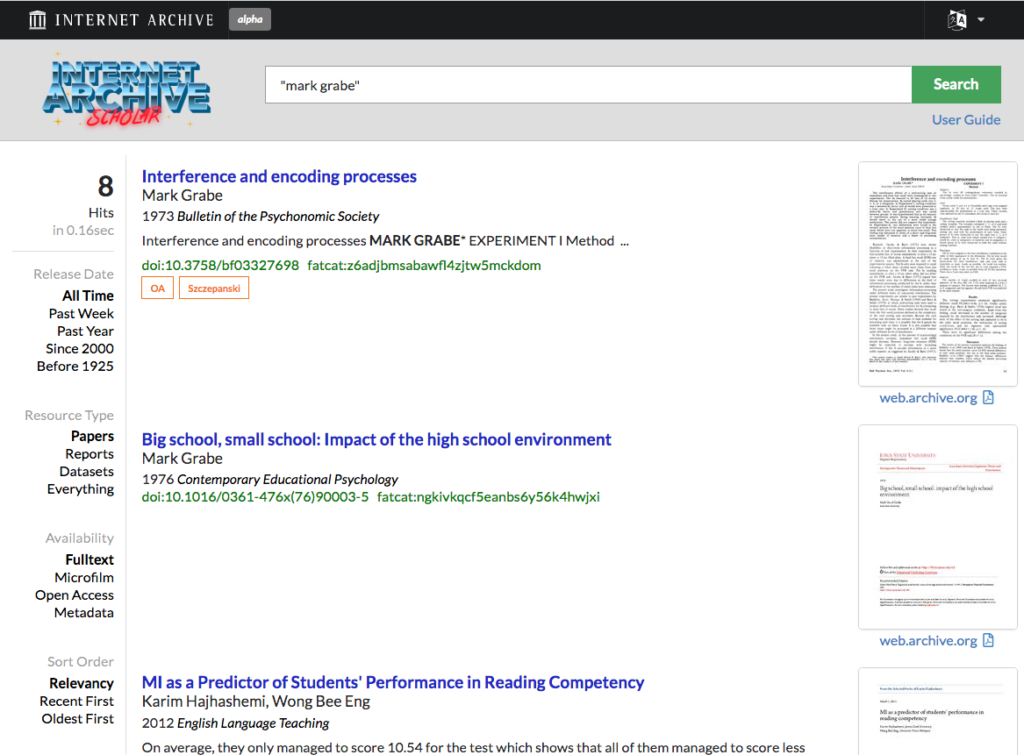
So, the Internet Archive found 8 hits for my name and some were references to my work and not information on my actual publications. I am not the most prolific scholar, but 8 is a little low. An interesting capability of the Archive is the opportunity to access actual articles. So, the 1973 article was published when I was an undergrad and the Contemporary Ed Psych article was based on my dissertation. What is interesting about this document is that it appears to be the full dissertation as stored in the Iowa State library and not the published version. If you take a look, you may be the first person other than those members of my committee and myself who have gazed upon this masterpiece.
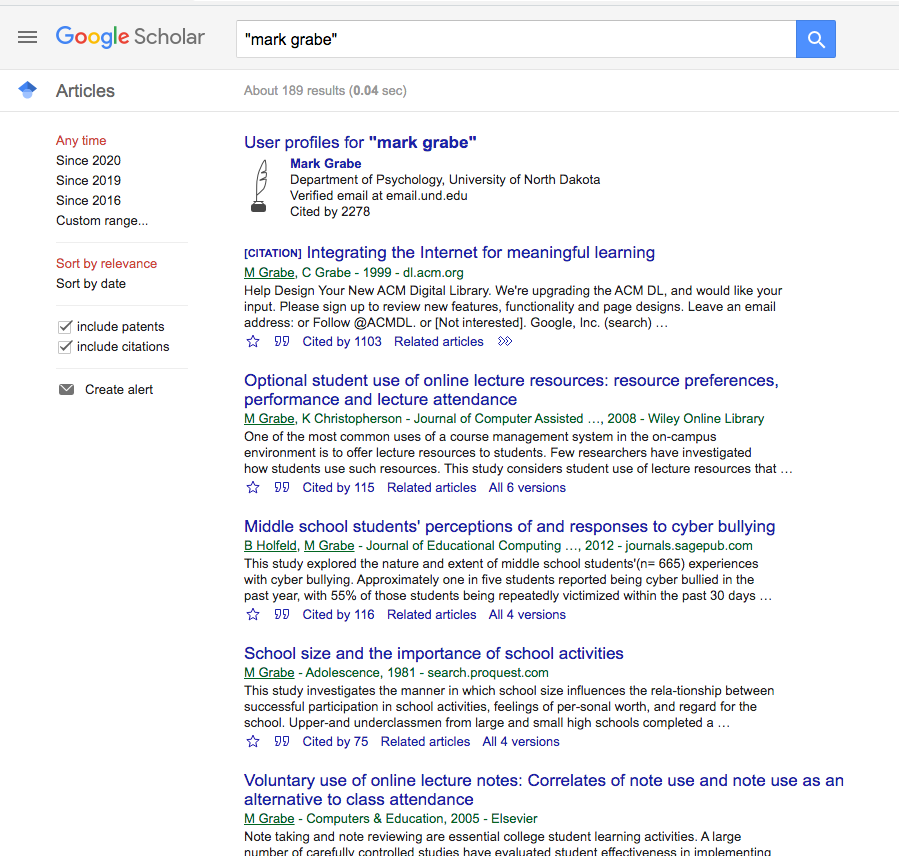
This is the same search conducted using Google Scholar. This search offers more resources and to prevent any misconceptions about my productivity the total includes many sources that cite my work and the work of students I worked with.
One of the significant issues in scholarly publication is the issue of access. When you try to access most of the publications listed here, you will be asked to pay for a copy. The amount tends to be quite substantial so I don’t know that anyone actually pays to receive a copy from the publisher. Some see this as unfair as our salaries as professors at state institutions are paid by citizens, but our work is not easily available to these citizens. Just to be clear for those not involved in higher ed, we are not paid for our publications from the outlets for our work. Different institutions may compensate researchers for publications (assumed to be a measure of productivity) as part of annual merit pay. For those interested, libraries located on college campuses typically have the journals containing these publications and many allow access to the stacks allowing visitors to make photocopies.
One more things – writing we do through a source such as this was not part of my actual job as a faculty member (I am not retired) and had no bearing on employment or salary. We do this type of writing for personal enjoyment and hopefully because we address topics that may be interesting for those in the public who have an interest in common with our own.
Interactive Media Bias Chart
I have recommended the Ad Fontas media bias chart before, but with the election nearing I thought it worth a repeat. The chart has panels of individuals rate attributes of individual articles from a news source on multiple dimensions and then uses an algorithm to position the source on a multidimensional graph based on these rankings (Method).
A recent version of the chart is interactive allowing you to request information about specific publications. I tried the Minneapolis Star Tribune (my local paper) and it was not included. So, I am unclear on how the sources covered were selected.

As an educational resource, this chart is interesting to explore and the methodology would be a good starting point for questions about the value of the press.
Social Dilemma
The Social Dilemma is a recent Netflix documentary from Jeff Orlowski. The video explores digital social media services and processes those responsible for these services use to maximize the commitment of viewer attention and the negative consequences of these processes. Be warned, the documentary is disturbing and pessimistic. The video makes the claim that these services go beyond the online world to serve as a disruptive force in society resulting in depression, division, and possible violence. This said I strongly encourage you to view the documentary.
I watched the film with Cindy. A couple of our kids also watched it on their own and discussed their resulting anxieties with Cindy. We ended up wondering why we were less bothered and decided it must be because of our personal experiences working with technology and our longer term view of technology and society. I have read the work of several of the experts appearing in the documentary and my background as a psychologist and long-time technologist provides some understanding of the cognitive and technological mechanisms at work.
Here is my simple description of the basic technological mechanisms I think users must appreciate. A core issue is that the dominant services of concern offer capabilities that are often very useful at no financial cost to users and it is this combination of value at no obvious cost that sets a dangerous trap. The point to appreciate here is that users have come to expect what they see as a free service and dominant providers would be quickly challenged by competitors if they now tried to charge. To cover their substantial personnel, infrastructure, and research and development costs, the free services rely on advertising. To optimize the revenue from advertising, these services began collecting data on user preferences in order to make the ads more appealing. As the potential of these data became more apparent, these companies started collecting data not only while viewing the services the company provided but also while users used other online services. The more data the better. Data = money.
Relevant ads attract more clicks and convince those who want ads displayed to pay more. The more ads that can be displayed the more revenue for the companies using ads as the core of funding. To display more ads it follows that the more time users spend using your service the more opportunities there are to display ads. I don’t blame companies for the decision to display ads as the need for revenue is obvious. In my thinking, the collection of user information associated directly with the use of a service is also acceptable. It is when the services start collecting information when not using their services (e.g,. third-party cookies) that the business model becomes questionable.
Two techniques lie at the core of concerns directed at social media services. First, providing content you want rather than content you need is a way to increase revenue. Google search results originally were based on an algorithm (page rank) that used a reasonable way to estimate the value/importance of content. As time went on, this algorithm was tweaked to augment value (e.g., most accurate) with variables associated with user values and interests. Again, what we should see because it is most accurate is not the same as what we might want to see. A related issue in some services would be prioritizing content that is like to generate an emotional reaction. Topics that get us upset, angry, satisfied, etc. create greater engagement and result in users spending more time.
Behavioral psychology is also playing a greater and greater role increasing time engaged and as a consequence ads viewed. Reinforcement for spending attention is a basic mechanism explained by behaviorism (note some try to use brain functions such as dopamine hits as a way to explain the same thing – I stick with an explanation that has been taught in Introductory Psychology for decades). By definition, reinforcement is defined as a consequence for behavior that increases the frequency of that behavior. What can services offer to provide reinforcement. The services don’t provide reinforcements directly, but provide mechanisms through which fellow users of the service can provide these reinforcements. Views, follows, likes, shares are experienced as reinforcements and we work to increase such consequences. Much in the same way emotional content generates greater attention, emotional content also generates more reinforcements. Our efforts are harnessed by the services to increase our attention to a service through such consequences.
I think there are measures you and can take to mitigate the mechanisms social media services use to capture our attention.
- Be mindful. Understanding the mechanisms I have identified and how they work can be used to your benefit. You don’t have to consistently provide reinforcements for others and you can indicate that you don’t want other users to respond to everything you post with likes and shares. Trust that others read what you write and assume others will trust you as well. Be aware that systems are you using your own online behavior to feed you information that will fit your biases. If you accept this is what happens you can take steps to defeat such bias. I will provide some techniques in the suggestions that follow.
- Limit your dependence on any given service within a given category. I set up my browsers to use different search engines – Google on my desktop, DuckDuckGo on my laptop, Bing on my other laptop. I do regard Google as the best and I will return to it should I not find what I think should be available. Sometimes there are reasonable alternatives to the most popular services within a category. I like PixelFed as an alternative to Instagram. Diaspora.social or wt:social as an alternative to Facebook.
- Limit the diversity of uses to which you put a given service. I try to limit my activity on Facebook to discussing political issues. I use Instagram for what most might describe as family sharing (I do not that Facebook and Instagram are services from the same company). I have written in several blogs for longer than Facebook has been around so I have outlets for what I write about other topics and perhaps more importantly I have some followers for these blogs. You will hear the phrase “network effect” as an explanation for the value of being on a service, even an inferior service, because everyone else is on the same service. This is the challenge in moving to other services. I try to recommend other services to others and I cross post content to ease what I eventually hope is a transition.
- Avoid features of services that feed bias. For example, I try not to pay attention to the recommendations when I use YouTube. When I search for something on YouTube, I have greater control of the experience. Once I start watching recommendations, I am letting the algorithm have much more influence. I can usually do this, but I often am distracted by music videos and once I start listing/watching these videos I can be distracted for hours. Several services offer a distinction between a less algorithmically driven feed and a “for you” feed. These feeds (news feed, Twitter and Facebook feeds) differ in the impact your history using the service has. Typically, when you opt for the less personally biased feed content selected for you will appear later as you move through content. Hence, the initial content is more neutral.
I use news feeds rather than a social media service to identify news I read. Both Apple News and Google News differentiate content that might be described as “Top Stories” and “For You”. The for you category is based on your history of content selection. BTW – Apple News+ is a paid service that allows you complete control of the content from a variety of content providers.

Both Facebook and Twitter offer a somewhat similar differentiation. In this case, there is an option that positions content at the top of your feed based on your past behavior and there is an option that first offers recent content from this you follow/friend before other content. In both cases, you set the approach you want.

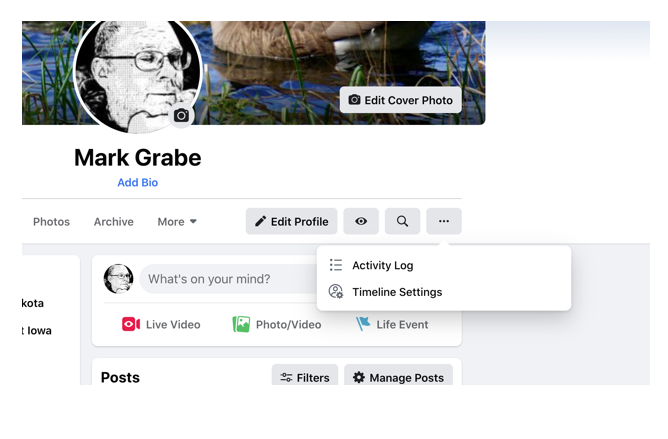

One final thought. Much of this situation involves the need to offer targeted ads in order to make money. There are ways around the ads. It is easy enough to block ads. As a matter of personal ethics, I don’t recommend blocking ads. This is unfair both to the social service and content creators who put a lot of work and money into generating and providing access to content. There are ways to block third-party ads and it is my impression that the popular services are moving in that direction. Instead, I prefer a browser and viewing environment called Brave. If you use a Chrome browser, you will be comfortable with Brave as it is based on chromium. Brave blocks ads and cookies. However, you can either contribute money or view Brave vetted ads to compensate the sites you visit. Sites must sign up with Brave, but this is not a difficult process. If you offer to view ads through Brave, you will generate funds that are divided among the sites you visit in proportion to the time you spend on those sites. Use the Brave link for more details.
Sharing a Wakelet Collection
Wakelet is a great free classroom tool for creating and sharing collections. These collections might be personal or group efforts and might be generated to serve a variety of educational goals. I have written about Wakelet previously. This effort is focused specifically on how to share a collection. Sharing might be done to show a completed effort or to invite collaborators to participate in an evolving project.
I needed an example for this demo so I decided to focus on the changing leaf colors of fall – why do leaves change colors and what are some examples of fall color that result. I am sharing my demo project for viewing only, but this topic would lend itself to group collaboration.
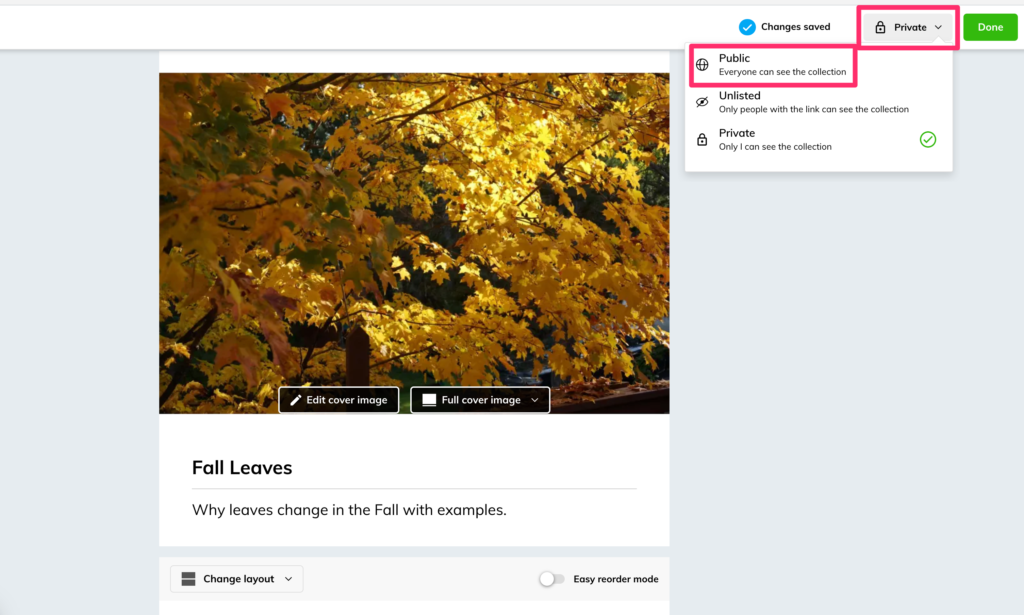
At the topic of a completed Wakelet project, you will see the dropdown menu for setting viewing rights. Here you can see I have set rights to public.
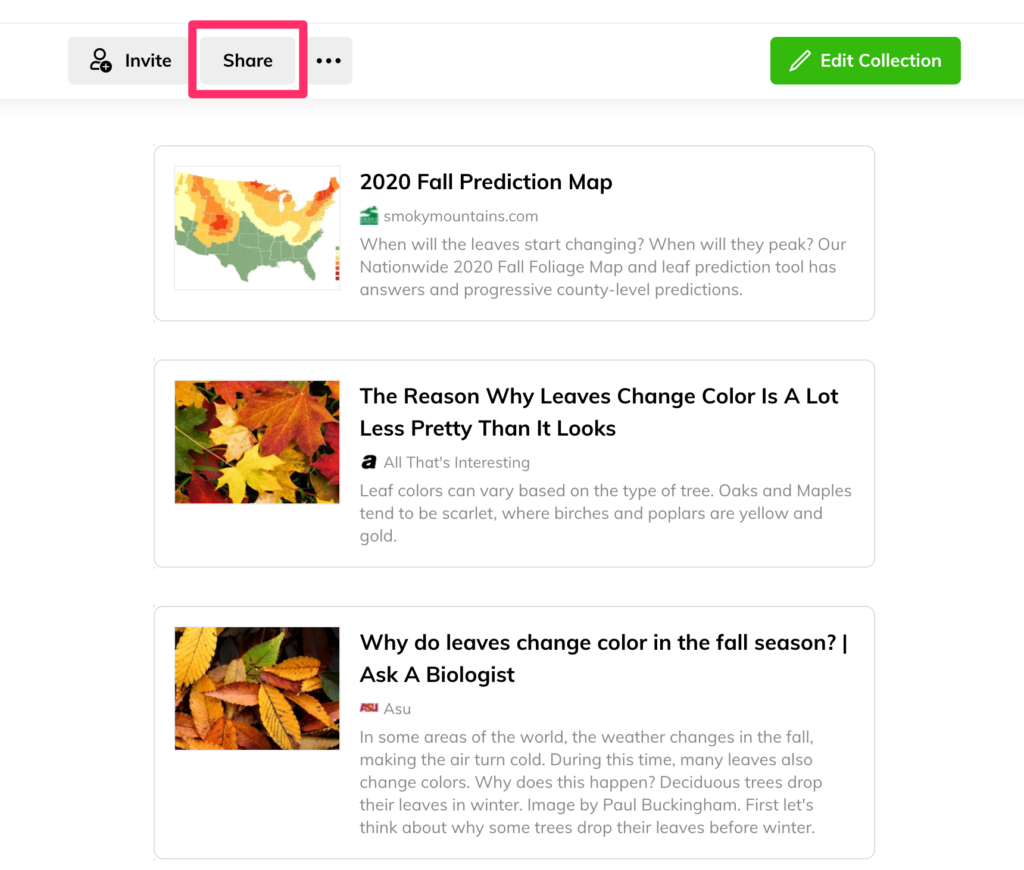
A project offers options for invitation and sharing. Invitation would offer the opportunity to others to contribute to a project. Sharing is the option for offering others viewing opportunities.
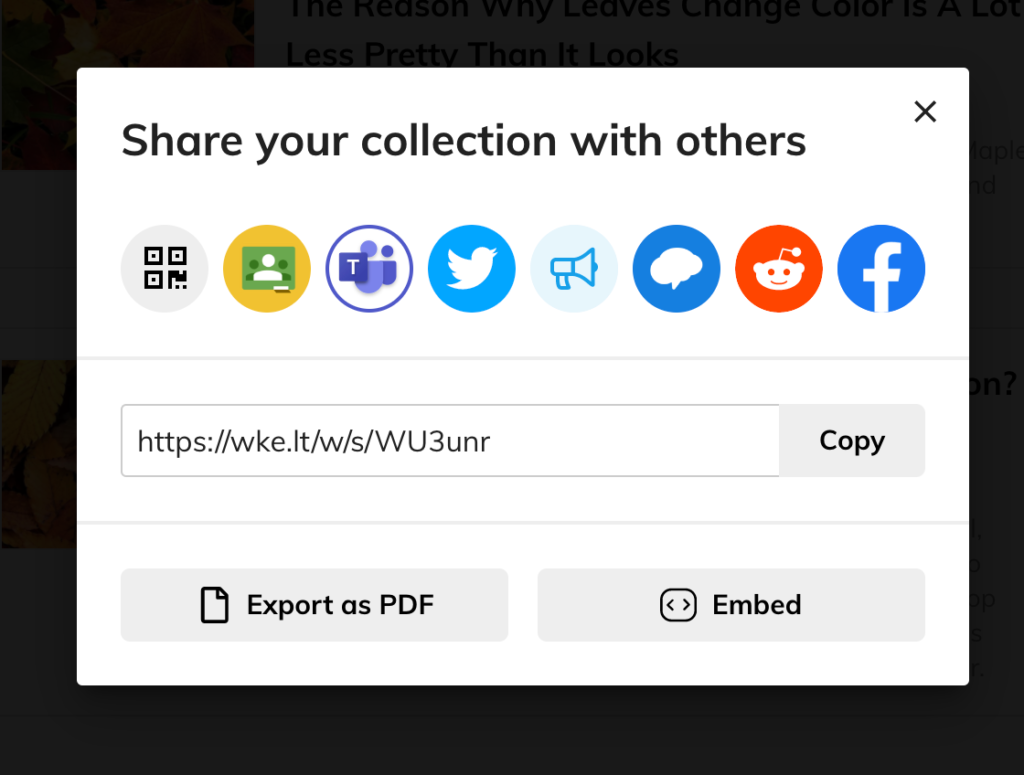
Selecting sharing brings up these opportunities. In this case I copied the URL for the collection so that you can view the project.

You must be logged in to post a comment.